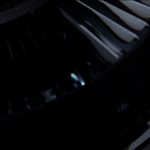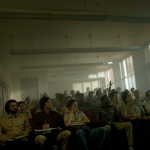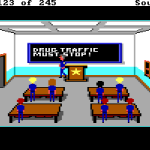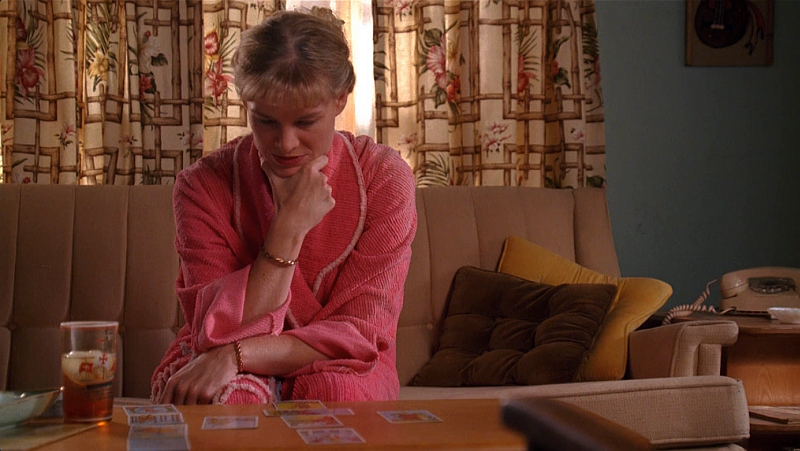
Reading Mad Men: Introduction
April 16, 2014 - Features / Reading Mad Men

I’ve been wanting for some time to start writing about how I watch Mad Men. I liked the show well enough when I started watching it, but I didn’t love it. At that point, the emerging style of contemporary TV drama reminded me a bit of Oscarbait: respectable, polished, and unchallenging. But I enjoyed the difficulty of the characters enough to keep going through the second season, at which point I saw a scene that changed how I watched the show. It happens in Season 2, Episode 12, “The Mountain King”: Dan’s friend Anna gives him a tarot reading.
I really like tarot, is the thing. It’s been a big part of my life since I was a teenager, when I spent a lot of my time looking for systems of meaning to get weird about. Tarot won out, and has since been the closest thing I have to anything approaching a religious practice. I collect decks, analyze the shit out of their imagery, and do readings for myself regularly. The readings help me calibrate how I feel about things and make decisions. I occasionally did readings for friends back in high school and college, but over the years it became more and more of an introspective thing. In the process, it became a framework through which I process the world.
So when tarot cards show up in fiction, I tend to overanalyze them. I’m usually disappointed by the results. What I love about tarot is the mix of constraint and ambiguity it offers. There’s a standard set of cards used in most modern decks, more or less unchanged since the Marseilles Tarot decks of the early sixteenth century. This includes the 52 pip cards that correspond to a normal deck of playing cards, plus an extra court card per suit: this 56-card set is known as the Minor Arcana. In addition, there are 22 cards known as the Trumps or Major Arcana. These are the ones you typically see more of in TV and film, because they’re more dramatic. Death, Justice, The Lovers, and the like.
These 78 cards each have traditional meanings in fortunetelling, but they can vary from deck to deck, especially in the Minor Arcana. Even within a card that’s relatively fixed, the meanings are broad and conceptual enough to be read in multiple ways. Death can mean a literal death, or a wrenching change, or the metaphoric death of a part of yourself, and so on. This, to me, is the heart of a good system of meaning: it fixes a theme to some extent, but allows context to work on the final meaning of a card. The meaning of Death in a given spread depends on the history of the card, the way a given artist has depicted it, the reader’s preconceptions, where it falls in the spread, surrounding cards, etc. A symbol with a history, and a context surrounding it. This is what has made the tarot such a useful tool for sorting through my own thoughts, which tend to be chaotic. I look at the cards and see a framework to fit my thoughts to. It calms me down and pulls out insights I might have otherwise ignored.
When fictional works use tarot cards, this is what I’m hoping for: a framework to fit my thoughts about the story to. It’s almost never what I get. I want a spread that provides a meaningful, complex commentary on the story’s themes. Generally, it’s just awkward foreshadowing.
But then, in “The Mountain King”, I finally got what I was looking for. Don goes to visit his mysterious friend Anna, and she reads his cards. I paused on the frame where the spread is shown, and for once, my scrutiny was rewarded. The spread is a really interesting commentary on the state of the story and Don’s character arc.

Anna uses a Celtic Cross spread, which is popular but also has a lot of variations in what the positions mean and what order they should be read in. I’m going to interpret it using the method I learned, but that’s not going to be the only way to read these cards. That’s the nature of the beast: lots of different valid interpretations.
The spread has two halves, the cross (on the left) and the staff (on the right). The cross is read first, starting in the middle, then the staff, starting from the bottom and going upwards. The positions are numbered like so:
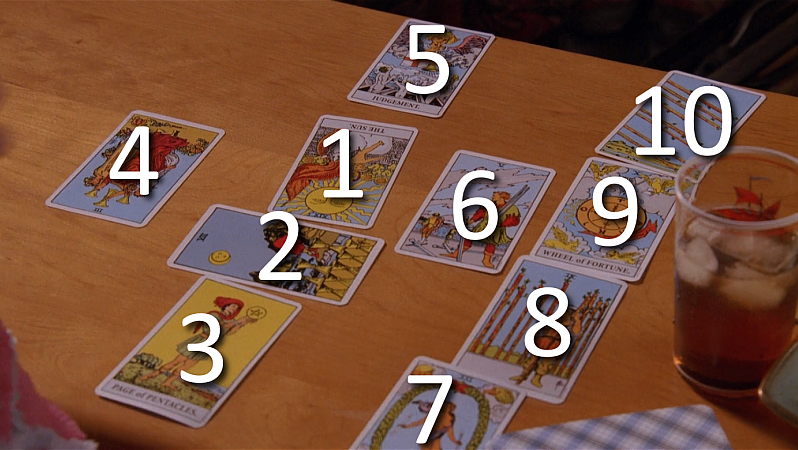
1. This covers it: The Sun, reversed
This position summarizes the overall situation. The Sun represents happiness and rebirth, but here it’s reversed (upside down). Traditionally, that means the original meaning of the card is blocked or corrupted. The reversal here suggests than Don is being prevented from achieving a happiness that is closer than he realizes. I’d also argue that The Sun in Mad Men is associated with California and the way Don idealizes it. Right now, he’s feeling weird about a trip to California.
2. This crosses it: 8 of Cups
Position 2 is an additional force that complicates the card in Position 1. The 8 of Cups depicts someone walking away from eight full cups, representing success. It’s a pretty clear reference to Don’s “hobo code,” the recurring theme of him running away without warning the second he feels unsatisfied with his life. In “The Mountain King” he’s in the middle of such an episode, having abandoned a work conference to dally with a stranger and eventually visit Anna.
Taken together, they say that Don’s basic problem is that his escape hatch keeps taking him away from the happiness he finds so elusive. (Note that the figure in the 8 of Cups is walking towards the moon.) It’s a pretty straightforward summary of his character arc in general, as well as where he’s at in “The Mountain King.”
3. It rests upon this: Page of Pentacles
The unconscious factors at the foundation of the matter. Here we see the Page of Pentacles, one of the “court cards.” These cards (which are similar to the Jack, King, and Queen from modern decks) usually represent people. Pages are traditionally children or young women (traditional tarot is super sexist!), and Pentacles are the earth suit, standing for material concerns. Here it probably represents young Dick Whitman, the boy living on the edge of survival in various “earthy” environments (a farm, a brothel). Don’s childhood experiences drive his adult problems more than he consciously realizes. In later seasons the show will make this an even more explicit theme.
4. This was before: 3 of Cups, reversed
Recent events. The 3 of Cups stands for pleasure and celebration. Reversed, it suggests a corruption of those things: overindulgence, hangovers, broken relationships. This sums up the events of “The Jet Set”, where Don became disenchanted with the hedonism of the idle rich he was hanging out with. This happened after he saw his new friend’s kids, who probably reminded him of his own unprotected childhood (calling back to the Page of Pentacles).
5. This crowns it: Judgement
This position stands for the asker’s conscious expectations of where things are heading. It could be a little joke that this is the one card Don points out himself. Don also interprets the card himself: “It’s the end of the world.” Which it is! But as Anna points out, it also represents resurrection and awakening into a new consciousness. This is a consistent theme in the tarot: things have to die for new things to be born. The final Judgement will be a painful change, but it will also free you from that coffin you’re stuck in. This alludes to the overall direction the series is heading in: the renewal of Don after a judgement of his life, which we see the first concrete steps towards at the end of Season 6, and the changes taking place in the country as a whole.
6. This comes after: 5 of Swords
The events that are about to take place. This 5 of Swords stands for a betrayal or humiliating defeat, a theme that weaves through various storylines in the next episode, “Meditations in an Emergency.” For example, Duck and Don’s maneuvering during the merger, the Cuban Missile Crisis, Betty temporarily giving up on her attempts to escape her marriage, Peggy’s extra-devastating rejection of Pete, etc.
7. This is the asker: The World
Anna goes into detail on this one so I’ll keep it short for now. I just want to note the little meta-commentary that Don, as the protagonist of the story, is connected to everything in The World in a literal sense as well.
8. This is where it takes place: 9 of Wands
How other people and factors outside of the asker influence their situation. The 9 of Wands depicts a man pausing between battles, a defensive wall behind him. It suggests the Cold War that hangs over the end of the season, and maybe the walls that various characters are building between themselves and others. Everyone’s shoring up their defenses in preparation for some kind of Judgement Day.
9. These are hopes and fears: The Wheel of Fortune
Usually you read this position as either “hopes” or “fears” depending on whether the card is positive or negative, but the card here isn’t really either. The Wheel of Fortune stands for chance and change. The loss of things you love, and the passing away of the things you feared. New factors coming to play. It can mean a lot of things here. Maybe it means that Don fears change and things he can’t control, which is true. It can also refer to two unexpected events currently taking place: the merger and Betty’s pregnancy. Don doesn’t know about either yet, but they will dominate his life over the next season. But The Wheel has some specific associations in the symbolic world of this show, which I’ll get to in the next article in this series.
10. This is where it leads: 8 of Wands
The final outcome of the conflict summarized in Positions 1 and 2. The 8 of Wands stands for rapid advancement of a situation. This could also call back to the whiplash changes Don’s facing when he gets back home. In the broader scope of the show, though, it suggests the breakneck pace of social change which will become a major theme of later seasons. It will be reflected in the lives of the characters as well, as changes in their domestic and work lives will become much faster and more dramatic from Season 3 onward. (For example: breakups for everyone! Some of you get two!) Don may be worried about Judgement Day in the abstract, but it’s coming a lot faster than he thinks.
* * *
I love this spread for what it offers about Don’s journey, but I also love how the scene describes Anna’s character. At this point in the show, she’s a mysterious element of Don’s background. We’re just learning about the nature of their relationship, but we don’t know much about Anna yet.
The tarot reading scene fills in a lot of the details about Anna’s personality and how she relates to Don. In this scene, we see Don and Anna interacting in a way that is visually typical for them over the course of the series. Anna is sitting in one place, Don is moving around restlessly, and they’re talking past each other in an amiable way. She’s his anchor as he moves around the life she’s made possible. And she usually entertains herself by reading him.
The way she reads tarot reminds me of the way I read tarot for myself. Instead of going card by card right away, she first takes in the overall pattern and addresses it. “You’re definitely in a strange place.” Then she lets Don give his input, terse as it is. She wants it to be a conversation, and she’s willing to wait for it if she needs to. As she goes through the reading, she tries to respond to what catches Don’s attention and points out how cards relate to each other. All of these things mark her as an experienced reader. She also does a very basic thing that a lot of tarot reading scenes miss: her interpretation of The World changes based on its position in the spread.
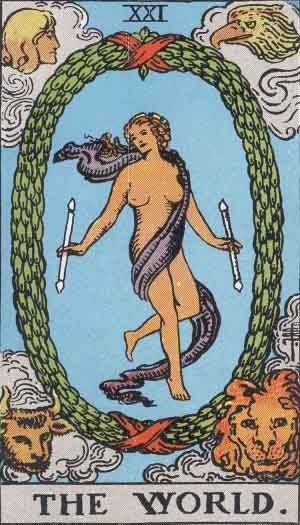
ANNA: She’s the soul of the world. She’s in a very important spot here. This is you, what you are bringing to the reading. She says you are part of the world. Air, water, every living thing is connected to you.
DON: It’s a nice thought.
ANNA: It is.
DON: What’s it mean?
ANNA: It means… the only thing keeping you from being happy is the belief that you are alone.
DON: What if that’s true?
ANNA: Then you can change.
DON: People don’t change.
ANNA: I think she stands for wisdom. As you live, you learn things.
One of the things I like about the scene is that Anna has an idiosyncratic read on what The World means in the position it’s in. Any tarot reader is going to have their own set of associations with individual cards. The way she reads The World is within the bounds of the card’s meaning, but it’s also very specific to how she sees Don. She knows him well and has her own ideas about what the card means for him.
She’s also trying to explain it in terms he might understand, even though this is clearly not his kind of thing. Anna sees major painful change coming for her friend (Judgement, The Wheel of Fortune, 8 of Wands) and she tries to focus him on the positive aspects of it and how he can survive it. In her read of The World, she’s telling him he needs to stop separating himself from others if he’s going to make it through what’s coming. She has an agenda, but she’s subtle about it. She knows Don won’t listen unless he comes to the idea on his own. (And he won’t, not for a long time.)
Since that long pause on Anna’s tarot reading, I’ve watched Mad Men differently. I don’t need a lot of encouragement to see tarot-related imagery everywhere, and the visual language of Mad Men proved fertile ground. The opening sequence always reminded me of The Tower: a collapsing building, a falling figure. I also noticed for the first time that Matthew Weiner’s production company logo was The Sun from the Rider-Waite deck, the center card of Anna’s spread. It was all I needed. From then on, I was reading tarot associations into every episode.
Over time, I started associating certain images or entire episodes with certain cards in the Major Arcana. These cards represent big, ambiguous concepts, and each is connected with its own network of iconography and meanings. Big, ambiguous conceptual images aren’t hard to find in Mad Men, with its reliance on advertising imagery and heavy symbolism. I can watch it the way I read a tarot spread: images and scenes arranged in a loose formation, with meaning arising from the juxtapositions. This has made certain themes and motifs resonate over the years I’ve been watching the show. And it’s provided openings for me to read myself into the show’s imagery, through connections I have with the cards they bring to mind.
In this series, I’ll be talking about these associations through a selection of episodes, each of which I relate to a specific card. I’m not going to make the argument that any of these associations are intentional on the creators’ parts. This is just a chronicle of how I watch the show. One thing that the creators clearly do intend is a strong use of visual symbolism and repeating motifs. Coming to it with my own language of symbols is a way of interacting with the text that I’ve found consistently rewarding. It pulls out a lot of specific themes of the show that overlap with traditional concerns of the tarot: the conscious and the subconscious, destruction and rebuilding of the self, and how people deal with change. I’d like to dig into that, and get the chance to talk about why this kinda Oscarbaity, kinda respectable show has come to mean so much to me.
